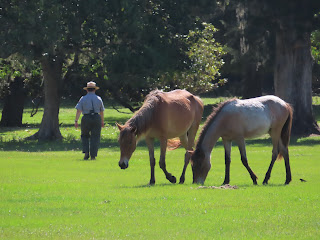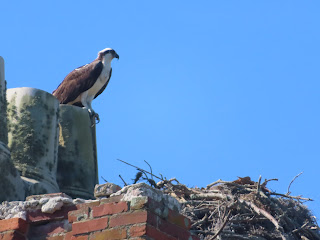Today, we rose early and took the ferry to the Cumberland Island National Seashore. It’s a place where history and nature meet. St Mary’s is the gateway to Cumberland Island, Georgia's largest and southernmost barrier island. The pristine maritime forests, undeveloped beaches and wide marshes whisper the stories of both man and nature. Natives, missionaries, enslaved African Americans and wealthy industrialists all walked here. Cumberland Island is 18-miles long and is also home to over 9,800 acres of congressionally designated wilderness.
After leaving the ferry, we started walking through the Maritime Forest toward the ruins. The Live Oaks form a dense canopy that shelters palmettos and delicate ferns cradled in branches.
Spanish moss sways
in the breeze. Painted bunting, summer tanagers, cardinals and pileated
woodpeckers add color to the forest’s palette.
For our first stop on the island, we also explored the ruins of the Dungeness Estate. It’s really a glaring 19th Century example of the privileged 1%, Thomas Carnegie (Andrew’s brother) and his wife Lucy bought 90 percent of Cumberland Island off the southernmost coast of Georgia. This included building a gigantic 59-room St. Ann style mansion on the south shores.
After being left abandoned and eventually burned, only ruins still remain. Initially planned as a winter getaway, after a series of illnesses, Thomas revised this to be his home in retirement. Construction began on the mansion in 1884, though, sadly, Thomas passed away before the estate was finished. When it was finally finished a few years later, Lucy and their nine children moved into the mansion. The estate also included an indoor pool, squash courts, a golf course, and other residences for the family’s 200 servants.
We asked a ranger for more information on the inhabitants of the island. We learned that there are still private residences on the island, with people living on the island include these residents, park rangers, volunteers and researchers. We learned that the horses, once domesticated, have reverted to a wild state and adjusted to surviving in a natural environment without help or support of any kind from humans. During their history on the island horses have been managed as both free-ranging and corralled livestock.
But by the mid-1900s horses were roaming the island with no care provided from island residents. Cumberland has the only herd of feral horses on the Atlantic coast that is not managed (no food, water, veterinary care, or population control). The herd is affected by all the natural stressors faced by native wildlife. The Cumberland’s horses are closely related to Tennessee Walkers, American Quarter Horses, Arabians, and Paso Fino. She told us they estimate between 150 and 200 feral horses in residence on the island. The lifespan of horses on the island may be as long as 9 to 10 years. Causes of mortality include high parasite loads, drought-related stress, age, natural accidents, and suspected eastern equine encephalitis and West Nile virus.
Some of us wanted to see the beach, so we walked and walked and walked. Before we found the beach, we found the Sand dunes, sometimes as high as 40-feet. They protect the island’s interior. These dunes, held in place by sea oats, are vital to the island’s ecosystem. We watched sand pipers scampering along the water’s edge and the sea gulls soaring on the ocean breezes. An Osprey may dive into a wave to emerge seconds later with a mullet.
Over 300 species of birds use the island and endangered sea turtles nest every year. Alligator, deer, turkey, armadillo and raccoon are commonly seen on the island.
an armadillo,
a bright green gecko
an Osprey with a nest
and a snake with a gecko in it's grasp!
For our first stop on the island, we also explored the ruins of the Dungeness Estate. It’s really a glaring 19th Century example of the privileged 1%, Thomas Carnegie (Andrew’s brother) and his wife Lucy bought 90 percent of Cumberland Island off the southernmost coast of Georgia. This included building a gigantic 59-room St. Ann style mansion on the south shores.
After being left abandoned and eventually burned, only ruins still remain. Initially planned as a winter getaway, after a series of illnesses, Thomas revised this to be his home in retirement. Construction began on the mansion in 1884, though, sadly, Thomas passed away before the estate was finished. When it was finally finished a few years later, Lucy and their nine children moved into the mansion. The estate also included an indoor pool, squash courts, a golf course, and other residences for the family’s 200 servants.
The estate flourished until the 1930s, and three other great estates (including Plum Orchard) were built elsewhere on the island for some of the children. With the advent of the Great Depression, the homes were slowly abandoned, as the island had no resources and everything had to be shipped in. Dungeness sat decaying until 1959, when a fire gutted the mansion, leaving only a skeletal group of ruins. Today, the ruins of the main house, the pool house, the gardens, and various other buildings still stand as a ghostly reminder of the wealth the island once contained. Although most of the island is now preserved under wildlife conservation efforts, we toured the exterior of the ruins and gained insightful knowledge of what the Dungeness mansion once looked like.
My main reason for wanting to travel to the island was to see the wild horses on the beach! But, first some history … A few horses were probably brought to Cumberland as livestock when Spanish missions were established in the late 1500s although evidence is sketchy. The earliest historic account of horses on Cumberland Island was in 1742. During the battle between the Spanish and the English over Fort St. Andrews on the north end of Cumberland, the Spanish found “fifty to sixty horses in a corral within the fort.” By the end of the 1700s, island landowners were reporting an estimate of 200 domestic horses and some mules kept as free ranging livestock on Cumberland.
During the early 1800s, several plantations were in operation on the island and horses played an integral role in transportation, work and recreation. In the turmoil during and after the Civil War, most of the horses were sold or otherwise removed from the island. When the Carnegie family moved to Cumberland in the 1880s, they brought horses for pulling carriages, riding, hunting and other recreational activities. Over 50 horses were stabled at Dungeness alone.
Throughout the 1900s, new stock was introduced and some horses were taken off the island for sale. Property owners on Cumberland managed horses as free ranging livestock from the 1940s until the 1960s. By the time the park was established in 1972, horses had become feral on the island. We never did see them on the beach!
We asked a ranger for more information on the inhabitants of the island. We learned that there are still private residences on the island, with people living on the island include these residents, park rangers, volunteers and researchers. We learned that the horses, once domesticated, have reverted to a wild state and adjusted to surviving in a natural environment without help or support of any kind from humans. During their history on the island horses have been managed as both free-ranging and corralled livestock.
But by the mid-1900s horses were roaming the island with no care provided from island residents. Cumberland has the only herd of feral horses on the Atlantic coast that is not managed (no food, water, veterinary care, or population control). The herd is affected by all the natural stressors faced by native wildlife. The Cumberland’s horses are closely related to Tennessee Walkers, American Quarter Horses, Arabians, and Paso Fino. She told us they estimate between 150 and 200 feral horses in residence on the island. The lifespan of horses on the island may be as long as 9 to 10 years. Causes of mortality include high parasite loads, drought-related stress, age, natural accidents, and suspected eastern equine encephalitis and West Nile virus.
Some of us wanted to see the beach, so we walked and walked and walked. Before we found the beach, we found the Sand dunes, sometimes as high as 40-feet. They protect the island’s interior. These dunes, held in place by sea oats, are vital to the island’s ecosystem. We watched sand pipers scampering along the water’s edge and the sea gulls soaring on the ocean breezes. An Osprey may dive into a wave to emerge seconds later with a mullet.
As we walked back toward the ferry, we took the saltwater marsh boardwalk. At low tide the marshes resemble broad, tall grass plains. Fiddler crabs scurry across the mud flats and eat decaying vegetation. Raccoons hunt for crabs and shellfish. At high tide, it is all washed away and the grasses sway with the current and disappear into it.
Over 300 species of birds use the island and endangered sea turtles nest every year. Alligator, deer, turkey, armadillo and raccoon are commonly seen on the island.
Besides the feral horses, we saw a turkey,
an armadillo,
a bright green gecko
an Osprey with a nest
and a snake with a gecko in it's grasp!
Stay tuned as our Adventure Continues!


















No comments:
Post a Comment